Abstract
Faecal bile acids and neutral sterols of cholesterol origin were decreased in patients with chronic liver disease, while urinary bile acids were constantly, but never greatly, increased. Thus, production of cholesterol and its conversion to bile acids was decreased in these patients. Faecal fat was only slightly increased, even in cases with a very low bile salt output, but it was negatively correlated with faecal bile acids. The reduced capacity of these patients to synthesize bile acids was shown by the fact that cholestyramine treatment, although it decreased urinary bile acids, increased faecal bile acids only slightly. The resin constantly increased faecal neutral sterols, while the increase of faecal fat was insignificant. Thus, the absorption of fats, as compared with that of sterols, was less strongly reduced by interruption of the enterohepatic circulation of bile salts. In one cirrhotic patient markedly increased faecal bile acids apparently caused cholerrhoeic diarrhoea, which was easily controlled with cholestyramine. The latter consistently increased elimination of cholesterol in cirrhotic patients, but serum cholesterol was not consistently decreased, and in these patients, in contrast to the control subjects, it was difficult to detect changes in cholesterol synthesis with the acetate-mevalonate test and serum methyl sterols.
Full text
PDF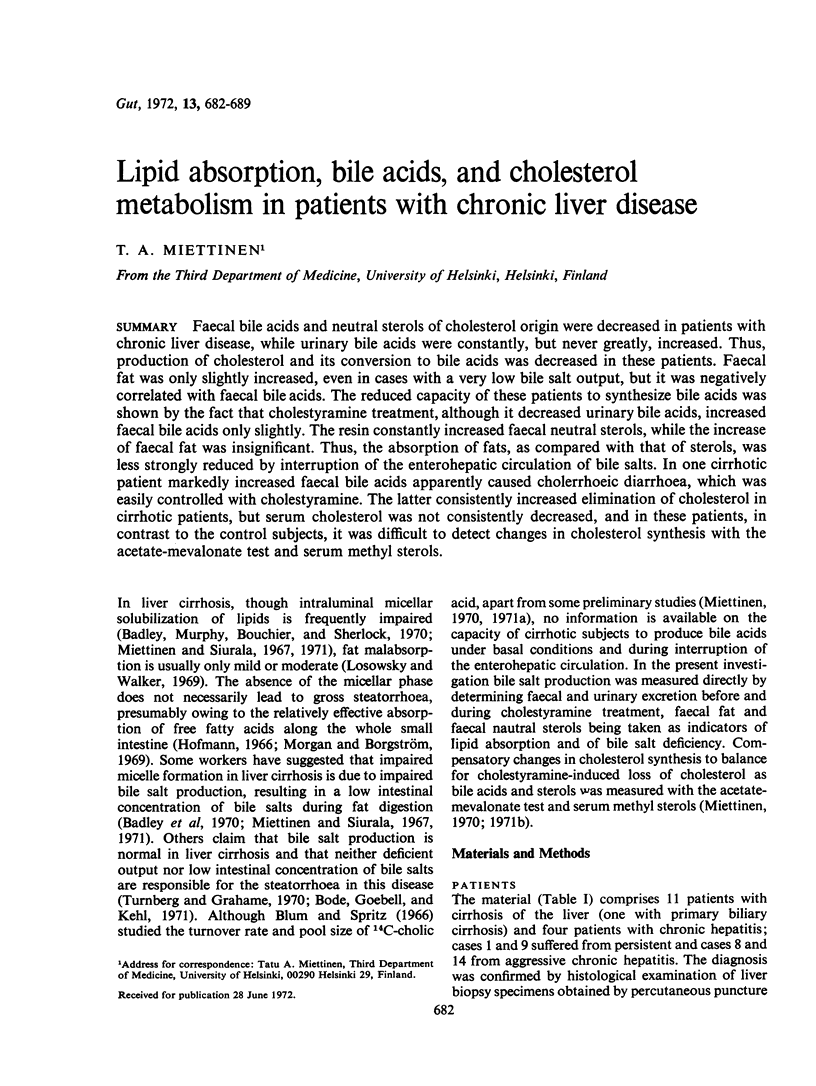
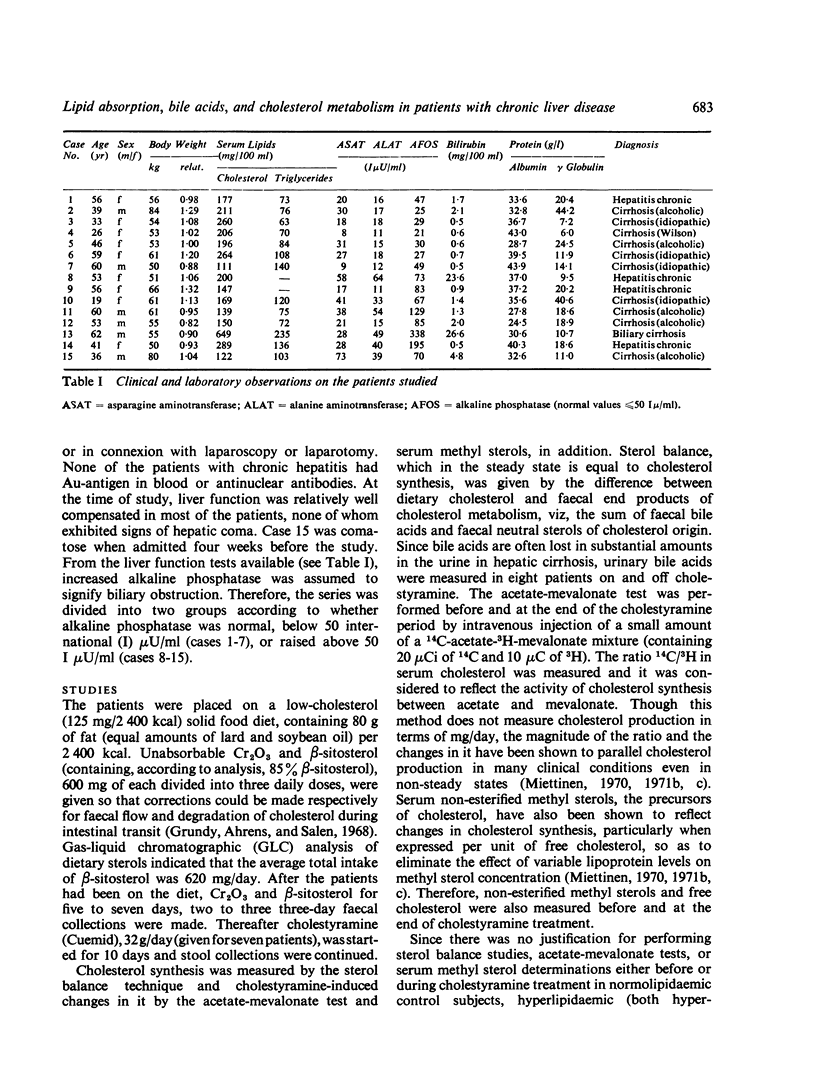
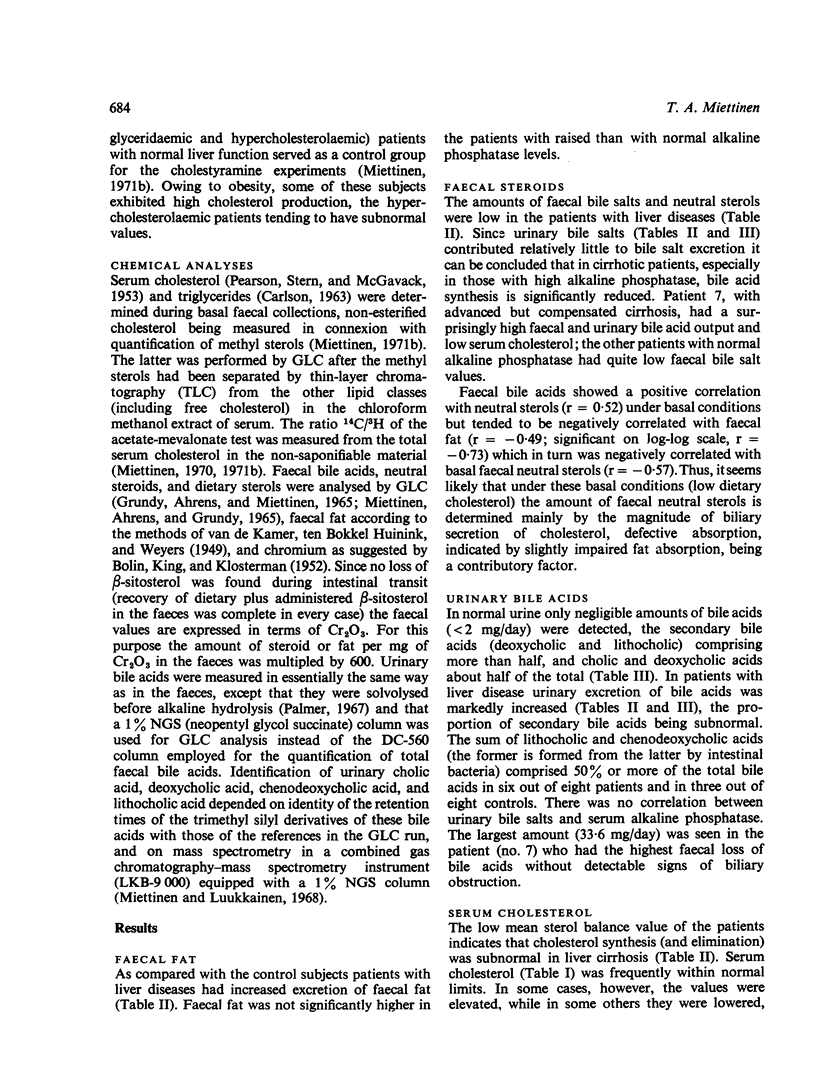
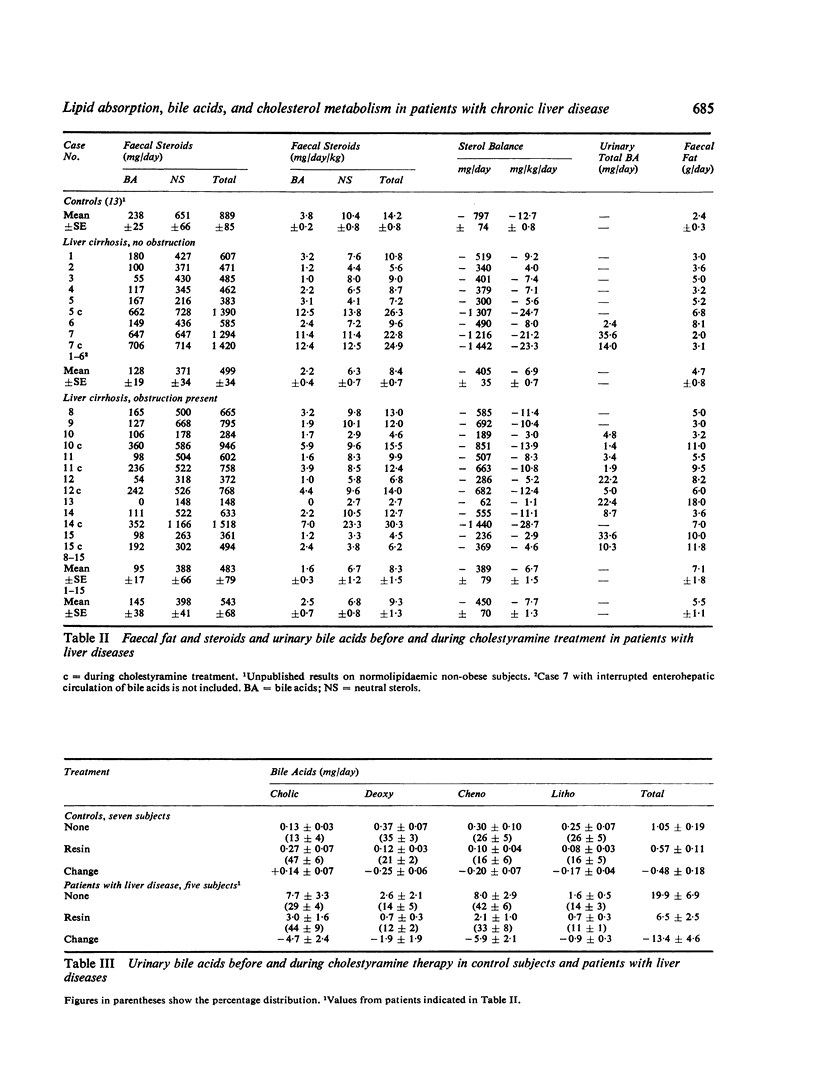
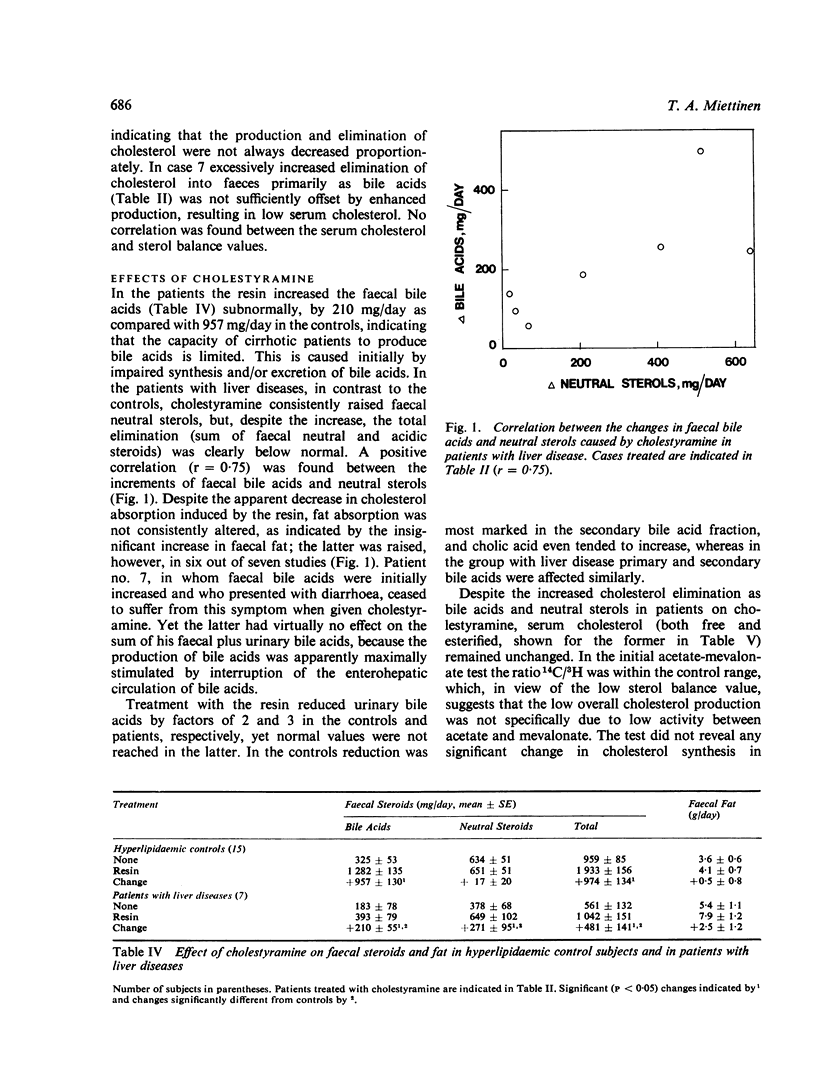
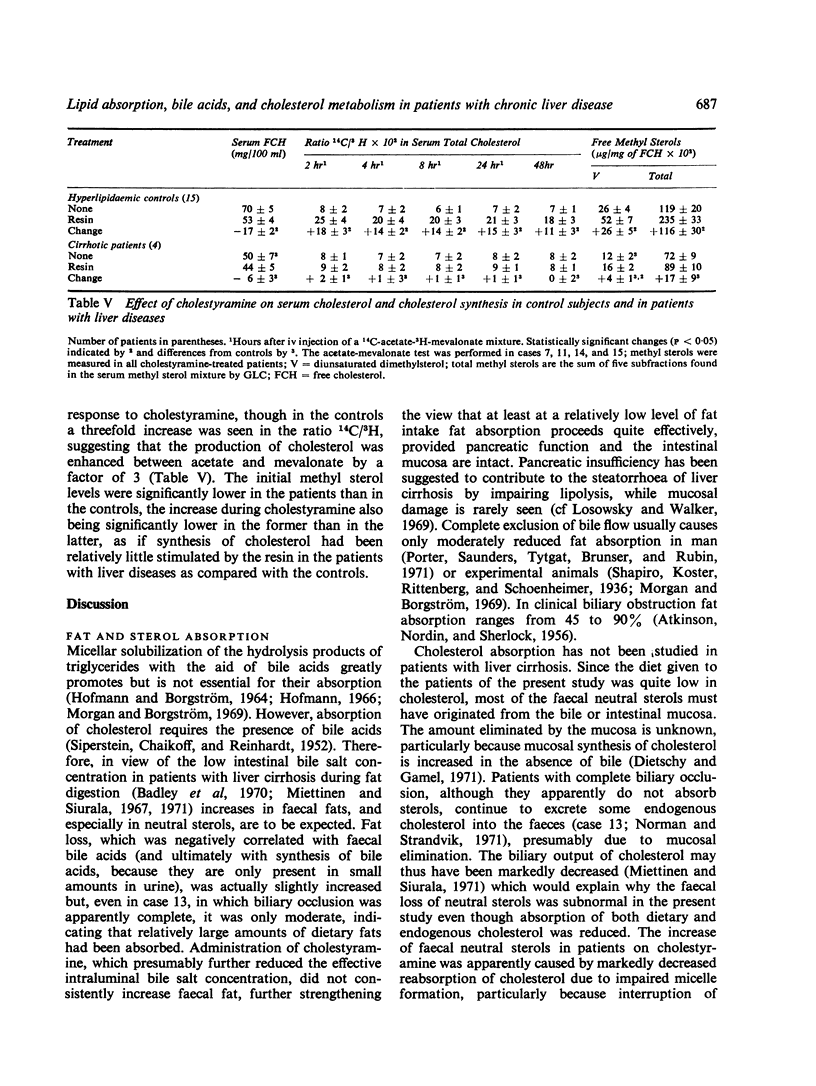
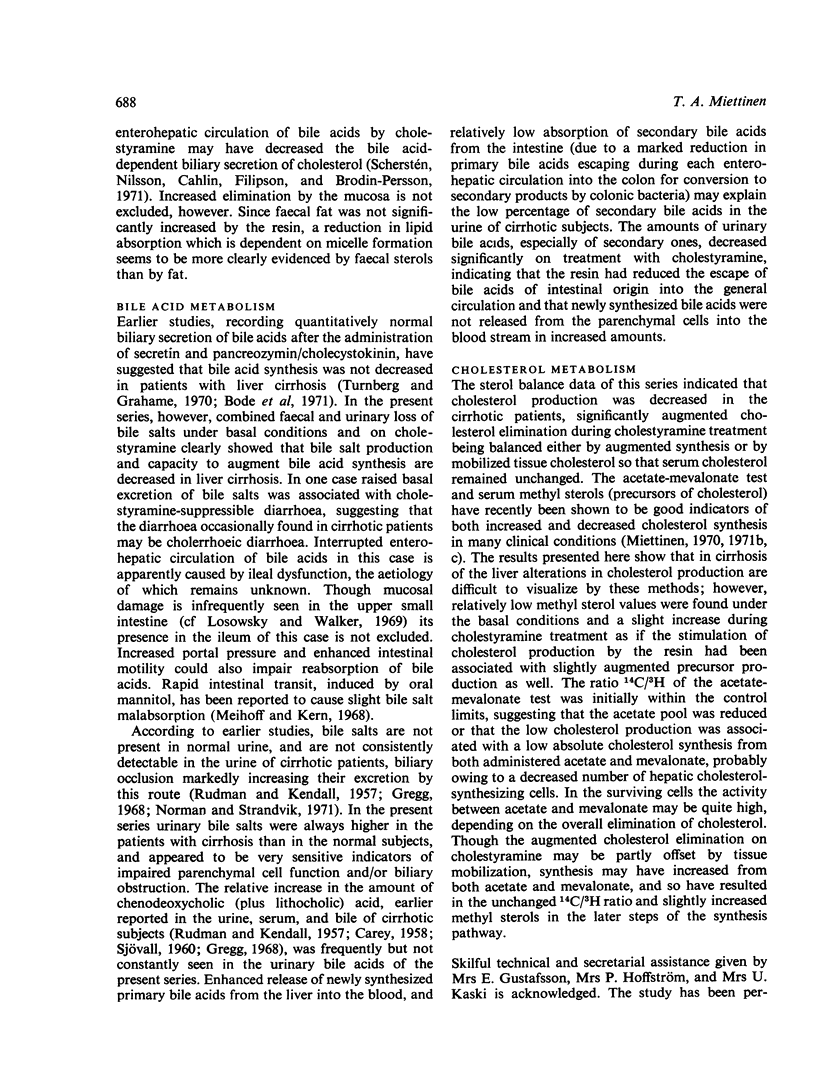
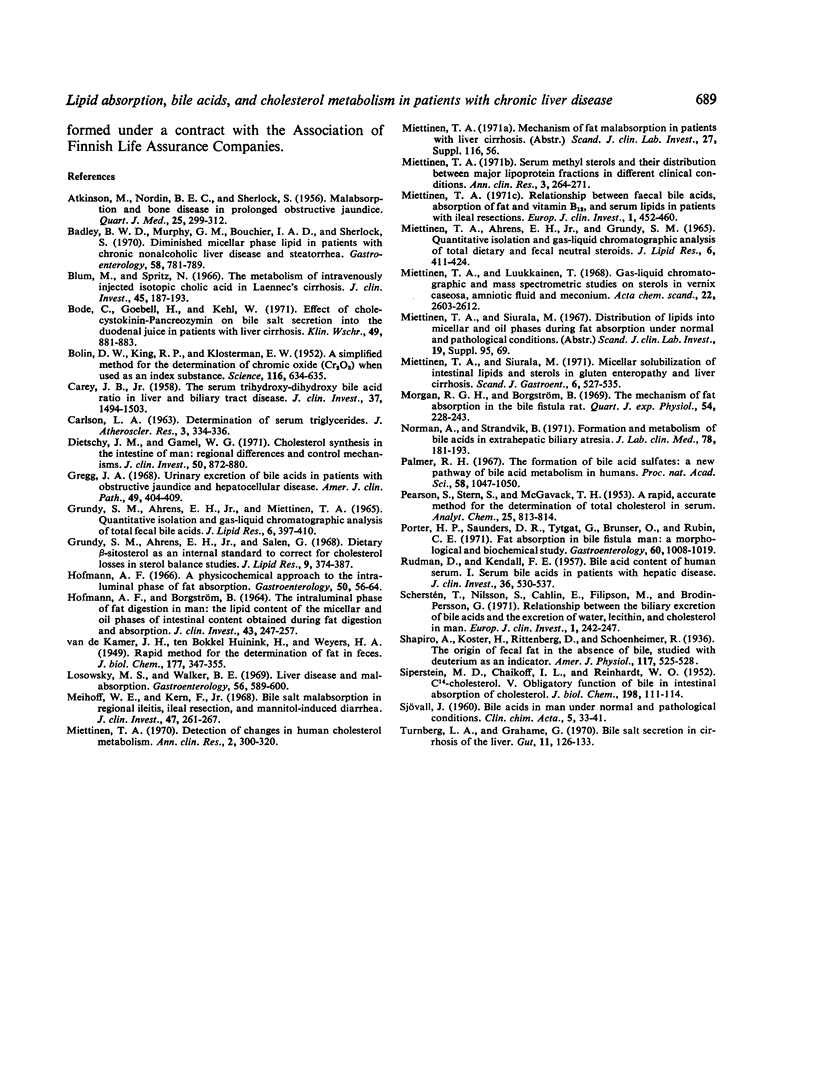
Selected References
These references are in PubMed. This may not be the complete list of references from this article.
- ATKINSON M., NORDIN B. E., SHERLOCK S. Malabsorption and bone disease in prolonged obstructive jaundice. Q J Med. 1956 Jul;25(99):299–312. [PubMed] [Google Scholar]
- BOLIN D. W., KING R. P., KLOSTERMAN E. W. A simplified method for the determination of chromic oxide (Cr2 O3) when used as an index substance. Science. 1952 Dec 5;116(3023):634–635. doi: 10.1126/science.116.3023.634. [DOI] [PubMed] [Google Scholar]
- Badley B. W., Murphy G. M., Bouchier I. A., Sherlock S. Diminished micellar phase lipid in patients with chronic nonalcoholic liver disease and steatorrhea. Gastroenterology. 1970 Jun;58(6):781–789. [PubMed] [Google Scholar]
- Blum M., Spritz N. The metabolism of intravenously injected isotopic cholic acid in Laennec's cirrhosis. J Clin Invest. 1966 Feb;45(2):187–193. doi: 10.1172/JCI105331. [DOI] [PMC free article] [PubMed] [Google Scholar]
- Bode C., Goebell H., Kehl W. Effect of cholecystokinin-Pancreozymin on bile salt secretion into the duodenal juice in patients with liver cirrhosis. Klin Wochenschr. 1971 Aug 1;49(15):881–883. doi: 10.1007/BF01513474. [DOI] [PubMed] [Google Scholar]
- CAREY J. B., Jr The serum trihydroxy-dihydroxy bile acid ratio in liver and biliary tract disease. J Clin Invest. 1958 Nov;37(11):1494–1503. doi: 10.1172/JCI103741. [DOI] [PMC free article] [PubMed] [Google Scholar]
- CARLSON L. A. DETERMINATION OF SERUM TRIGLYCERIDES. J Atheroscler Res. 1963 Jul-Aug;3:334–336. doi: 10.1016/s0368-1319(63)80012-5. [DOI] [PubMed] [Google Scholar]
- Dietschy J. M., Gamel W. G. Cholesterol synthesis in the intestine of man: regional differences and control mechanisms. J Clin Invest. 1971 Apr;50(4):872–880. doi: 10.1172/JCI106559. [DOI] [PMC free article] [PubMed] [Google Scholar]
- GRUNDY S. M., AHRENS E. H., Jr, MIETTINEN T. A. QUANTITATIVE ISOLATION AND GAS--LIQUID CHROMATOGRAPHIC ANALYSIS OF TOTAL FECAL BILE ACIDS. J Lipid Res. 1965 Jul;6:397–410. [PubMed] [Google Scholar]
- Gregg J. A. Urinary excretion of bile acids in patients with obstructive jaundice and hepatocellular disease. Am J Clin Pathol. 1968 Mar;49(3):404–409. doi: 10.1093/ajcp/49.3.404. [DOI] [PubMed] [Google Scholar]
- Grundy S. M., Ahrens E. H., Jr, Salen G. Dietary beta-sitosterol as an internal standard to correct for cholesterol losses in sterol balance studies. J Lipid Res. 1968 May;9(3):374–387. [PubMed] [Google Scholar]
- HOFMANN A. F., BORGSTROEM B. THE INTRALUMINAL PHASE OF FAT DIGESTION IN MAN: THE LIPID CONTENT OF THE MICELLAR AND OIL PHASES OF INTESTINAL CONTENT OBTAINED DURING FAT DIGESTION AND ABSORPTION. J Clin Invest. 1964 Feb;43:247–257. doi: 10.1172/JCI104909. [DOI] [PMC free article] [PubMed] [Google Scholar]
- Hofmann A. F. A physicochemical approach to the intraluminal phase of fat absorption. Gastroenterology. 1966 Jan;50(1):56–64. [PubMed] [Google Scholar]
- Losowsky M. S., Walker B. E. Liver disease and malabsorption. Gastroenterology. 1969 Mar;56(3):589–600. [PubMed] [Google Scholar]
- MIETTINEN T. A., AHRENS E. H., Jr, GRUNDY S. M. QUANTITATIVE ISOLATION AND GAS--LIQUID CHROMATOGRAPHIC ANALYSIS OF TOTAL DIETARY AND FECAL NEUTRAL STEROIDS. J Lipid Res. 1965 Jul;6:411–424. [PubMed] [Google Scholar]
- Meihoff W. E., Kern F., Jr Bile salt malabsorption in regional ileitis, ileal resection and mannitol-induced diarrhea. J Clin Invest. 1968 Feb;47(2):261–267. doi: 10.1172/JCI105722. [DOI] [PMC free article] [PubMed] [Google Scholar]
- Miettinen T. A. Detection of changes in human cholesterol metabolism. Ann Clin Res. 1970 Dec;2(4):300–320. [PubMed] [Google Scholar]
- Miettinen T. A., Luukkainen T. Gas-liquid chromatographic and mass spectrometric studies on sterols in vernix caseosa, amniotic fluid and meconium. Acta Chem Scand. 1968;22(8):2603–2612. doi: 10.3891/acta.chem.scand.22-2603. [DOI] [PubMed] [Google Scholar]
- Miettinen T. A. Relationship between faecal bile acids, absorption of fat and vitamin B 12 , and serum lipids in patients with ileal resections. Eur J Clin Invest. 1971 Sep;1(6):452–460. doi: 10.1111/j.1365-2362.1971.tb00557.x. [DOI] [PubMed] [Google Scholar]
- Miettinen T. A. Serum methyl sterols and their distribution between major lipoprotein fractions in different clinical conditions. Ann Clin Res. 1971 Oct;3(5):264–271. [PubMed] [Google Scholar]
- Miettinen T. A., Siurala M. Micellar solubilization of intestinal lipids and sterols in gluten enteropathy and liver cirrhosis. Scand J Gastroenterol. 1971;6(6):527–535. doi: 10.3109/00365527109181669. [DOI] [PubMed] [Google Scholar]
- Morgan R. G., Borgström B. The mechanism of fat absorption in the bile fistula rat. Q J Exp Physiol Cogn Med Sci. 1969 Apr;54(2):228–243. doi: 10.1113/expphysiol.1969.sp002021. [DOI] [PubMed] [Google Scholar]
- Norman A., Strandvik B. Formation and metabolism of bile acids in extrahepatic biliary atresia. J Lab Clin Med. 1971 Aug;78(2):181–193. [PubMed] [Google Scholar]
- Palmer R. H. The formation of bile acid sulfates: a new pathway of bile acid metabolism in humans. Proc Natl Acad Sci U S A. 1967 Sep;58(3):1047–1050. doi: 10.1073/pnas.58.3.1047. [DOI] [PMC free article] [PubMed] [Google Scholar]
- Porter H. P., Saunders D. R., Tytgat G., Brunser O., Rubin C. E. Fat absorption in bile fistula man. A morphological and biochemical study. Gastroenterology. 1971 Jun;60(6):1008–1019. [PubMed] [Google Scholar]
- RUDMAN D., KENDALL F. E. Bile acid content of human serum. I. Serum bile acids in patients with hepatic disease. J Clin Invest. 1957 Apr;36(4):530–537. doi: 10.1172/JCI103450. [DOI] [PMC free article] [PubMed] [Google Scholar]
- SIPERSTEIN M. D., CHAIKOFF I. L., REINHARDT W. O. C14-Cholesterol. V. Obligatory function of bile in intestinal absorption of cholesterol. J Biol Chem. 1952 Sep;198(1):111–114. [PubMed] [Google Scholar]
- Scherstén T., Nilsson S., Cahlin E., Filipson M., Brodin-Persson G. Relationship between the biliary excretion of bile acids and the excretion of water, lecithin, and cholesterol in man. Eur J Clin Invest. 1971 Jan;1(4):242–247. doi: 10.1111/eci.1971.1.4.242. [DOI] [PubMed] [Google Scholar]
- Turnberg L. A., Grahame G. Bile salt secretion in cirrhosis of the liver. Gut. 1970 Feb;11(2):126–133. doi: 10.1136/gut.11.2.126. [DOI] [PMC free article] [PubMed] [Google Scholar]


